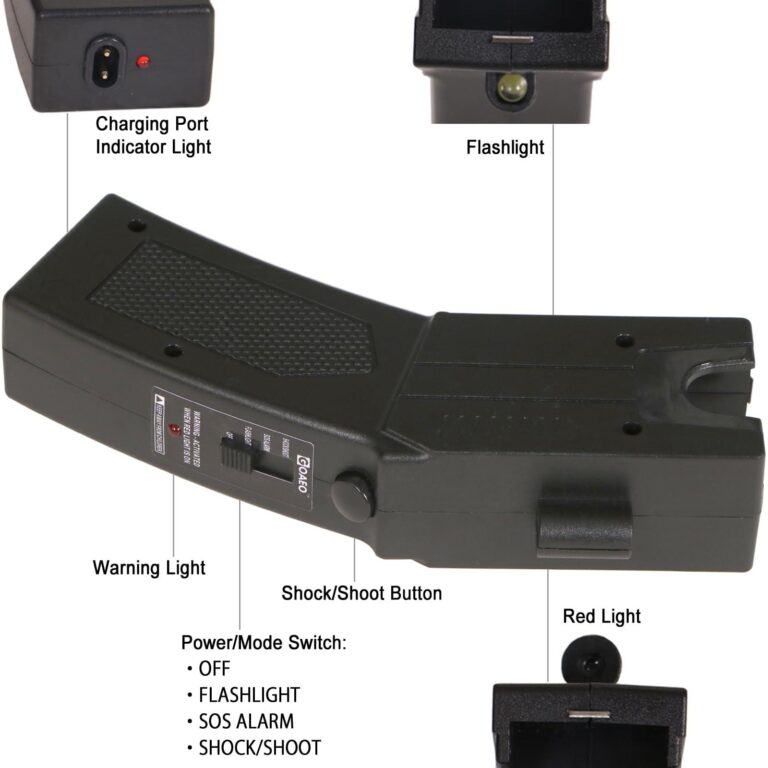Table of Contents
- Understanding the Metal Components in Stun Guns and Their Impact on Detection
- How Metal Detectors Work and Why Stun Guns Often Trigger Alarms
- Best Practices for Carrying Stun Guns in Security-Sensitive Areas
- Tips for Choosing Stun Guns That Minimize Detection Risks
- Key Takeaways
Understanding the Metal Components in Stun Guns and Their Impact on Detection
At the core of every stun gun lies a variety of metal components primarily responsible for its electrical functionality and structural integrity. These typically include copper wiring, steel electrodes, and metal casing elements that facilitate the device’s discharge capacity. The presence of such metals, especially in significant quantities or dense forms, can increase the likelihood of detection by mainstream metal detectors. However, the detection sensitivity often depends on the size, material composition, and design of the stun gun’s internal structure.
When it comes to metal detection, not all metals contribute equally to visibility. Here are key factors influencing how metal components impact detection:
- Metal type and density – Heavier metals like steel produce stronger signals compared to lighter metals such as aluminum.
- Component placement – Metals concentrated near the surface of the device are more easily detected than those buried deep inside.
- Size and quantity – Larger metal parts or multiple discrete metal items collectively raise the detection signature.
Understanding these nuances helps in assessing why many stun guns, despite their compact nature, may still be spotted by security checkpoints equipped with modern metal detection systems.
How Metal Detectors Work and Why Stun Guns Often Trigger Alarms
Metal detectors operate by emitting an electromagnetic field, which interacts with metallic objects passing through the scanning area. When a metal object, such as a stun gun, enters this field, it disturbs the signal, triggering an alarm. The detection process depends largely on the size, composition, and shape of the metal, as detectors are calibrated to recognize common threat items like weapons and large metal accessories. Unlike modern scanners that also profile materials, traditional metal detectors focus primarily on metallic conductivity, making it challenging to bypass detection if the stun gun has substantial metal components.
Why stun guns frequently set off alarms:
- Stun guns contain significant metal parts, including electrodes and internal wiring, which are easily detected by the scanning technology.
- The compact but dense nature of the metal in stun guns creates a distinct signature recognized by security systems.
- Many stun guns incorporate safety switches or metal casings that increase their detectability.
Best Practices for Carrying Stun Guns in Security-Sensitive Areas
When carrying stun guns in environments where security is a top priority, it’s essential to understand and adhere to strict guidelines to avoid complications during security checks. First, always verify the local laws and regulations governing stun gun possession in the area you are entering, as restrictions can vary significantly. Equip yourself with a high-quality carrying case that fully encloses the device to minimize the chances of detection by metal detectors. In many cases, stun guns contain metal components, making them detectable unless properly shielded or stored in a manner compliant with security protocols.
Additionally, transparency with security personnel is highly recommended to ensure a smooth screening process. Some best practices include:
- Declaring the stun gun upfront: Inform security staff about the device before the screening begins.
- Carrying proper documentation: Keep permits or licenses readily accessible to present when asked.
- Using designated storage compartments: Place the stun gun in bags or compartments specifically designed to comply with metal detection procedures.
- Securing the stun gun effectively: Ensure the device is turned off and safely maintained to prevent accidental discharge or alarm triggers.
Tips for Choosing Stun Guns That Minimize Detection Risks
When selecting a stun gun with the intent to reduce the likelihood of setting off metal detectors, focus on models crafted with non-metallic or low-metal components. Many modern stun guns now incorporate materials such as high-grade plastics or polymers, which significantly lower their metal signature. Opt for compact designs, as bulkier devices tend to feature larger metallic parts, increasing detection risk. Additionally, consider the stun gun’s electrode configuration-less exposed metal prongs not only improve concealability but can also cut down on the overall metallic footprint.
Another crucial factor is the type of battery used. Lithium-ion batteries often have a smaller metal presence compared to traditional alkaline batteries, making devices lighter and less detectable. It’s also beneficial to examine the stun gun’s certification and product reviews to ensure it meets legal standards and balances discretion with effectiveness. To summarize, prioritize:
- Materials: Non-metal or minimal metal construction
- Size: Compact, lightweight design
- Battery type: Low-metal or lithium-ion batteries
- Electrode design: Covered or minimized metal tips
Key Takeaways
In summary, while stun guns often contain metal components that can trigger metal detectors, the level of detection can vary based on the device’s design and the sensitivity of the security equipment. Understanding how stun guns interact with metal detectors is crucial for both personal safety and compliance with security protocols. Whether you’re considering carrying a stun gun for self-defense or are simply curious about security measures, staying informed ensures you make responsible and lawful decisions. Always check local regulations and guidelines before carrying any self-defense device, and remember that responsible ownership goes hand in hand with effective personal protection.Check Our Other Blogs
- StunGun – Your Trusted Source for Stun Guns, Laws, and Self-Defense Tips
- PepperSprayLaws – Your Trusted Resource for Pepper Spray Information
- StunGunLaws – Your Trusted Guide to Stun Gun Legality and Safety



